
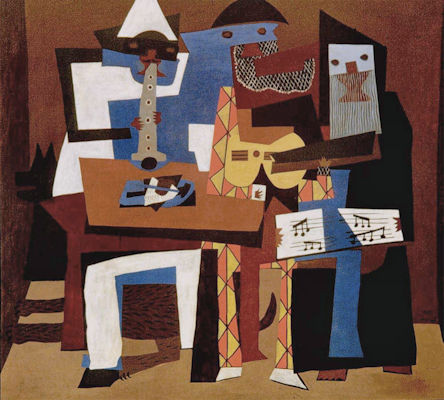
“Three musicians”. Pablo Picasso, 1921.
Due to its otherworldliness, no metaphor can illustrate the Trinity perfectly. Yet some metaphors are better and some are worse. This one is not so successful: “If three drops of water are put into a bowl, they become one, but there are still three drops of water in the bowl”. Another bad analogy is that the Trinity is like the sun, i.e., the sun as such, its heat, and its light. But this makes light (the Christ) and heat (the Spirit) secondary to the sun. It smacks of unitarianism. We can do better, while also avoiding images that lead our thoughts in the direction of modalism or tritheism. My following proposals are inspired by quantum physics, optics, mathematics, music and chemistry. Remember that they are all defective, some way or the other. It’s up to the reader to figure out how.
1. Quantum complementarity as metaphoric of the natures of the Christ and the Trinity
In De Trinitate Augustine grapples with the question of how ‘two can be one’ in the hypostatic union and ‘three can be one’ in the Trinity:
Those three seem both to be bounded or determined by each other, and yet in themselves to be unbounded or infinite. But in bodily things down here one is not as much as three are together, and two things are something more than one thing; while in the supreme Trinity one is as much as three are together, and two are not more than one, and in themselves they are infinite. (VI. 12)
Yet, in quantum physics, not only can two be one but also three can be one. When pairs of particles interact, quantum entanglement may occur. In consequence, the quantum state of either particle can no longer be described independently of the other, even when they are separated by a large distance. If either particle changes state, the other one does too, even if they are light-years apart. No signal goes between them. This occurs because the two particles belong to one and the same quantum system. So this is a case where two is one. Scientists have also created entangled states of three photons (cf. ScienceDaily, 2019).
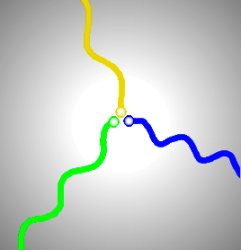
Entangled photon triplet.
Another example is the wave-particle duality of light. Light can be described either as a shower of photons or as a wave propagating through space. Although these two descriptions are conflicting, they nevertheless make up one phenomenon, namely that of light. This is according to the principle of (binary) complementarity. Importantly, Plotnitsky remarks that “complementary relationships may be extended into triple or more multiple configurations” (1994, p. 75).
Complementarity (binary and ternary) is suitably metaphoric of Christ’s dual nature and the Trinity, although it’s also a fact of nature. Accordingly, Augustine would have seen complementary phenomena as imperfect images of the divine in the created order. Had he known about quantum physics, he would have made much of it. In Answer to the Pelagians I he says:
And thus by reason of the distance between the divinity and human weakness, the Son of God remained in heaven, and the Son of Man lived on earth. But by reason of the unity of the person, by which the two substances are the one Christ, the Son of God lived on earth, and the Son of Man remained in heaven. (60)
I wonder what a physicist would think about this argument, considering that divine entanglement and quantum entanglement are equally intelligible.
2. The optical spectrum as metaphor for the divine persons
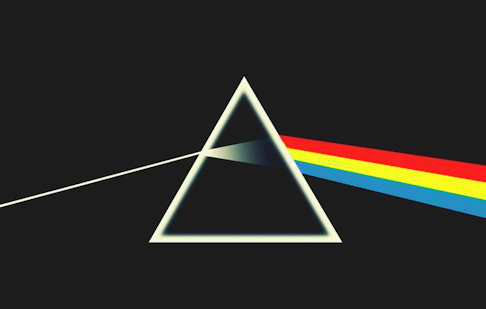
God is like a white light that, refracted by a prism, reveals itself in three different colours with a distinct character. God as Trinity is only knowable in stories of revelation; in the encounters of the Trinity with the world. The prism is like the gateway to the world. The white light is ‘ineffable’. It illustrates that the persons are of one essence according to their unity. It also illustrates the full equality of the persons and their unity of action in the world. The three colours are visible to the human eye, because any of the three persons may reveal himself to the believer, as Augustine explains. But the spectrum colours are continuous and not discreet.
3. The Trinity is like a mathematical function with three minimum points
f(x) = (1 - x)² (2 - x)² (3 - x)² + 1
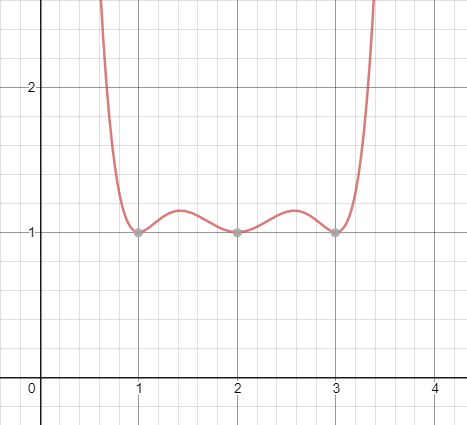
The y-axis represents the heavenly dimension and the x-axis the earthly. God proceeds from eternity in the vertical extension and manifests in the earthly dimension as three different x-values (1, 2, 3). As God is one, the function generates one for whichever value of x = 1, 2, 3. All three persons are equally God, because their common divine value is one. Note that the function is continuous and therefore there is no separation between the persons.
4. The Trinity is like three dual chemical compounds, formed out of three elements
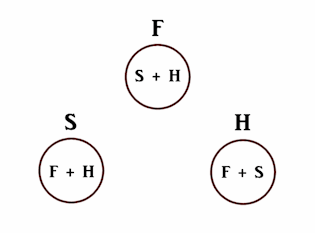
In the doctrine of the Trinity, there is a mutual indwelling of the persons in one another (perichoresis). In the diagram, the essence of the Holy Spirit (H) is the “chemical compound” of the Father and the Son, conformant with Augustine’s notion that the Spirit is the love between Father and Son in an appropriated sense. Together, they breathe forth the Holy Spirit. (Evidently, the essence is not identical to the Holy Spirit, for he is a person and not an essence.) Comparatively, if the elements hydrogen and oxygen are combined, we get a compound called water. It has very special characteristics, much different than its constituent elements. Thus, each divine person emerges from the combined indwelling of the other two. It means that each compound also functions as an element in the other two, which is an impossibility in earthly chemistry. But this only makes the metaphor better.
Each person is a trinity in itself, which accords with the doctrine that they act indivisibly. We also see that there is no essence that the persons have in common, as it would constitute a fourth element in the Trinity, “prior” to the Trinity, as it were. Still, the Trinity is its own essence according to its unity. It conforms with Augustine’s view that God’s nature is neither exclusively relational nor exclusively metaphysical. It is both in an incomprehensible way. All three are substances in themselves although predicated relatively.
5. The Trinity is like the three quarks that are the building stones of matter
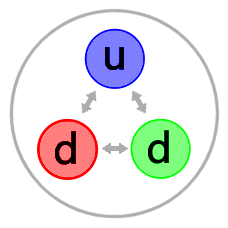
Scientists don’t know why stable matter (protons and neutrons) must constitute of exactly three quarks of different colour-charge. (Protons have two up-quarks whereas neutrons have two down-quarks.) But Augustine knows, as he explains that the Trinity is reflected in nature and in the human soul. There is no Platonic formless matter (hyle) since at the innermost level there is also form (Confessions, 13), yet not perfectly according to his image: “[T]hose things which merely exist and yet do not live or know are in his likeness, not completely, but in a slight degree, because even they are good in their own order” (Responses to misc. questions, 51). The quarks maintain their unity by continually exchanging colour charges. Thus, the quarks are always changing colour, while maintaining the rule that there must always be three different colours. It is reminiscent of the mutual indwelling that creates the unity of the Trinity.
6. The Trinity is like three ants cooperating
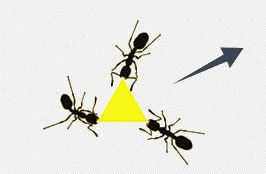
Augustine says that the Trinity is reflected in the natural order. When ants cooperate to carry something, they tend to pull in different directions. Yet, the resultant vector is in the general direction of the anthill (cf. Berman, 2010). It illustrates the unified will of the Trinity. If it’s true that the divine persons “pull” differently, it seems to necessitate three different yet complementary theologies, i.e., a theology of the Father, the Son and the Holy Spirit, respectively. Maybe it explains why Christianity has three major branches; Catholic, Protestant, and Orthodox.
7. The Trinity is like three musicians playing a trio sonata
Although they play on different instruments, the musical piece created is a wholeness. Theologian Wolfhart Pannenberg thinks that the cooperative action of the persons takes form as the one God (cf. Pannenberg, 1992, p. 430).
8. The Trinity is like the three additive primary colours
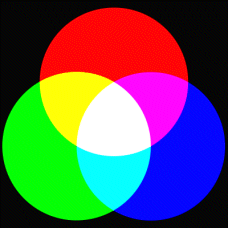
The three additive primary colours are red, green, and blue. That’s why standard monitors only have Red, Green and Blue pixels (RGB) and why all browsers support RGB colours. By superimposing these three colours we can get the whole spectrum visible to the human eye. So a trinity of colours gives all colours. The colour trinity is a wholeness of colours.

© Mats Winther, 2019.
Definitions
from Dictionary of Theology. CARM:
Modalism
The Trinity
Tritheism
Unitarianism
References
Augustine, St. (2016). The Works of Saint Augustine: A Translation for the 21st Century. New City Press.
Berman, S. et al. (2010). ‘Study of group food retrieval by ants as a model for multi-robot collective’ in Robotics: Science and Systems VI. The MIT Press. (here)
‘Complementarity (physics)’. Wikipedia article. (here)
Pannenberg, W. (1992). Systematic Theology I. T & T Clark International.
‘Perichoresis’. Wikipedia article. (here)
Plotnitsky, A. (1994). Complementarity – anti-epistemology after Bohr and Derrida. Duke University Press.
‘Quantum entanglement’. Wikipedia article. (here)
‘Quark’. Wikipedia article. (here)
‘Researchers create first three-photon color-entangled W state.’ ScienceDaily, 23 September 2019. (here)
‘Wave–particle duality’. Wikipedia article. (here)
See also:
Winther, M. (2021). ‘ “Turtles all the way down” : The Unity of the Trinity as Eternal Regress in the Godhead’. (here)